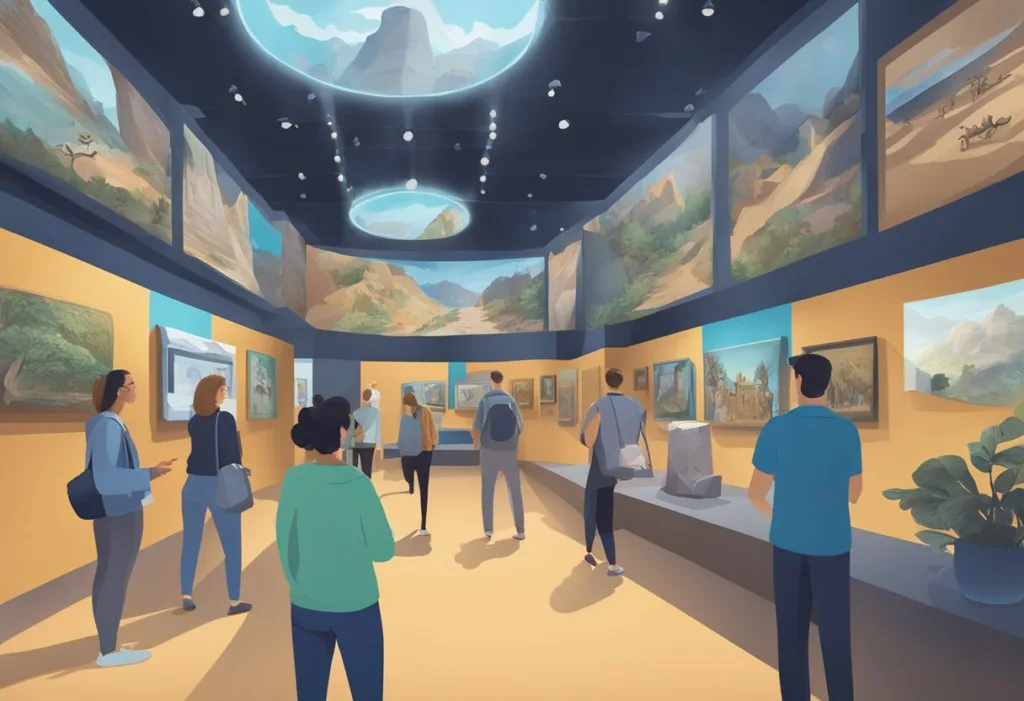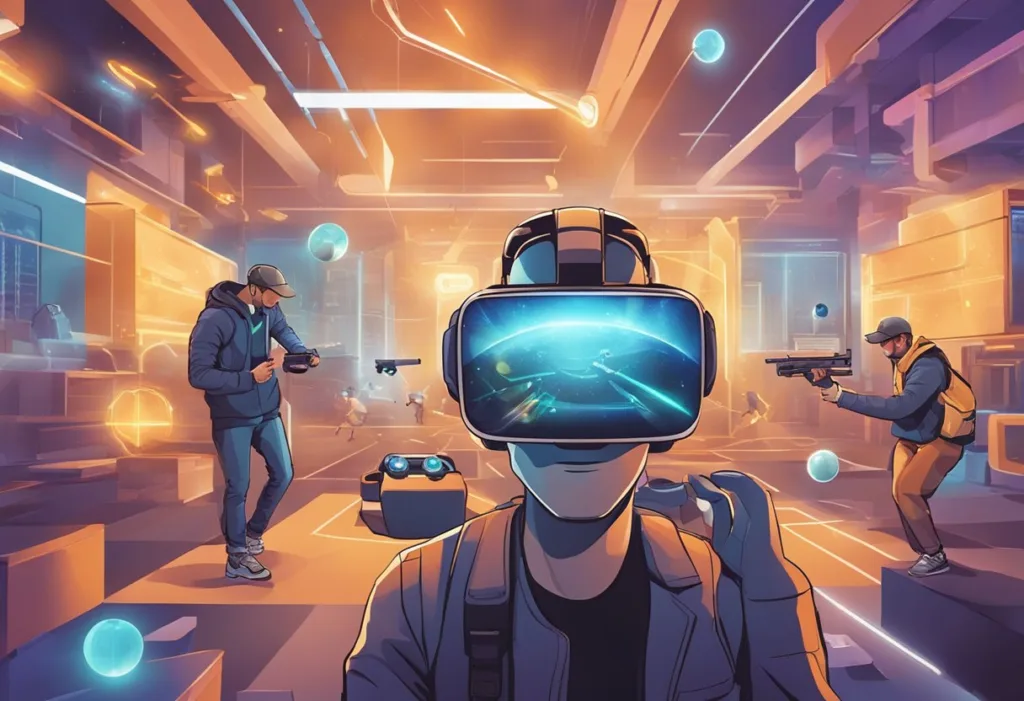Metaverse programming is a relatively new field that has emerged as a result of the growing interest in virtual reality, augmented reality, and immersive experiences. The metaverse, a term coined by Neal Stephenson in his novel Snow Crash, refers to a collective virtual shared space that is created by the convergence of multiple virtual worlds. It is a space where people can interact with each other and with virtual objects in a seamless manner.
Metaverse programming involves developing software and applications that can be used in the metaverse. This includes developing applications for virtual reality and augmented reality platforms, as well as developing applications that can be used to create immersive experiences. Metaverse programming requires knowledge of programming languages such as C++, Java, and Python, as well as knowledge of virtual reality and augmented reality technologies. In the following sections, we will explore the different aspects of metaverse programming in more detail, including the programming languages used, the technologies involved, and the applications that can be developed.
Fundamentals of Metaverse Programming
Understanding the Metaverse
Metaverse programming involves creating virtual worlds and experiences that are interactive, immersive, and engaging. The Metaverse is a term used to describe a collective virtual shared space that is created by the convergence of physical and digital worlds.
It includes virtual reality (VR), augmented reality (AR), and other forms of digital experiences. Metaverse programming requires a deep understanding of the technologies and platforms that are used to create these experiences.
Core Technologies and Platforms
Metaverse programming involves using a wide range of programming languages, platforms, and tools. The most popular programming languages for Metaverse programming are Python, JavaScript, C#, C++, Rust, and Java. These languages are used to create the backend systems that power the Metaverse.
The most popular platforms for Metaverse programming are Unity and Unreal Engine. These platforms provide developers with the tools and resources they need to create immersive and interactive experiences.
Metaverse programming also involves using artificial intelligence (AI) and machine learning (ML) to create intelligent and responsive virtual worlds.
AI and ML are used to create NPCs (non-player characters) that can interact with players in a natural and intuitive way. They are also used to create intelligent environments that can respond to player actions in real-time.
Metaverse programming is a complex and challenging field that requires a deep understanding of programming languages, platforms, and technologies. Developers who are interested in Metaverse programming should have a passion for creating immersive and interactive digital experiences.
Top 9 Programming Languages for Metaverse Development
Metaverse development is a rapidly evolving field that requires a diverse set of programming languages. The following are some of the top programming languages that are used for metaverse development:
- C# (Unity)
- Unreal Engine C++
- JavaScript
- Python
- Rust
- Lua
- C# (outside of Unity)
- GDScript
- Java
C# (Unity)
C# is a popular programming language used for developing games and applications on the Unity game engine. It provides a robust and versatile environment for Metaverse game development.
With a large community, extensive documentation, and a wide range of libraries and tools, C# in Unity has powered popular Metaverse projects like VRChat and Rec Room.
Unreal Engine C++
Unreal Engine C++ is a powerful programming language used for developing games and applications on the Unreal Engine. It is a high-level programming language that provides a lot of flexibility and power to developers. Unreal Engine C++ is used extensively in the development of Metaverse projects like Fortnite and Robo Recall.
JavaScript
JavaScript is a go-to programming language for modern AR and VR web-based applications. Whether you’re building a digital product on the blockchain or if you are coding directly for new metaverse experiences, like VR games, JavaScript is a good choice.
It is a popular language for web development and is used extensively in the development of Metaverse projects like Decentraland and Somnium Space.
Python
Python is one of the programming languages best suited to machine learning, making it a popular choice for developing intelligent agents in the Metaverse. It is also used for backend development and data analysis in Metaverse projects like The Sandbox and Axie Infinity.
Rust
Rust is a systems programming language that is used for developing high-performance applications. It is a popular language for developing blockchain-based Metaverse projects like Decentraland and Somnium Space.
Lua
Lua is a lightweight programming language that is used for developing games and applications. It is a popular language for developing Metaverse projects like Roblox and Second Life.
C# (outside of Unity)
C# is a versatile programming language that can be used for developing games and applications outside of the Unity game engine. It is a popular language for developing Metaverse projects like High Fidelity and Sansar.
GDScript
GDScript is a scripting language used for developing games and applications on the Godot game engine. It is a popular language for developing Metaverse projects like VRChat and Rec Room.
Java
Java is a popular programming language used for developing enterprise applications. It is also used for developing Metaverse projects like Minecraft and OpenSim.

Design and User Experience
Creating Engaging Virtual Environments
Designing virtual environments for the metaverse requires a unique blend of creativity and technical skills. To create engaging virtual environments, designers must consider the user experience, immersion, and interactivity. They must also consider the hardware limitations of the target platform.
Designers can use tools such as Blender for 3D modeling, animation, and texturing. They can also use game engines such as Unity and Unreal Engine to create interactive experiences.
Design Principles for Interactive Experiences
Design principles for interactive experiences in the metaverse include spatial design, visual hierarchy, color palettes, and user flow. Spatial design is particularly important in the metaverse because it involves creating a sense of presence and immersion for the user.
Designers must also consider the user’s perspective and how they will interact with the virtual environment. They must use color palettes and visual hierarchy to guide the user’s attention and create a cohesive experience.
Building Avatars and Digital Twins
Avatars and digital twins are representations of the user in the metaverse. Building avatars and digital twins requires a combination of 3D modeling, animation, and programming skills. Designers must consider the user’s preferences, identity, and interactions when creating avatars and digital twins.
They must also consider the hardware limitations of the target platform. Designers can use tools such as Blender for 3D modeling and animation. They can also use programming languages such as C# and Python to create interactive behaviors for avatars and digital twins.
Metaverse Infrastructure and Ecosystem
The Metaverse infrastructure and ecosystem are the backbone of the Metaverse, and they play a crucial role in enabling the creation and delivery of digital experiences.
The Metaverse infrastructure includes network providers, programming standards, and virtual worlds/platforms, and it should be designed to handle and process large amounts of data and power real-time capabilities that demand extremely fast responses.
Blockchain and Decentralization
Blockchain technology is a key component of the Metaverse infrastructure, and it enables decentralization, which is a foundational principle of the Metaverse.
Blockchain technology allows for the creation of decentralized applications that can be used to power virtual worlds and other digital experiences. Decentralization ensures that the Metaverse is not controlled by any single entity, and it enables users to have more control over their digital assets.
Economy and Digital Assets
The Metaverse economy is based on digital assets, such as non-fungible tokens (NFTs), which are unique digital assets that can be used to represent ownership of virtual items.
The Metaverse economy is expected to be a multi-billion dollar industry, and it is expected to grow rapidly in the coming years. Digital assets are an essential component of the Metaverse ecosystem, and they enable users to buy, sell, and trade virtual items.
Security and Privacy Considerations
Security and privacy are critical considerations in the Metaverse ecosystem. The Metaverse must be designed to be secure and protect user data and privacy. As the Metaverse grows, it will become a more attractive target for hackers and other malicious actors.
Therefore, it is essential to build a robust security infrastructure that can withstand attacks and protect user data. Privacy is an essential consideration in the Metaverse, and users must have control over their data and be able to decide who has access to it. Governance is also an important consideration, and the Metaverse ecosystem must be designed to ensure that it is governed in a fair and transparent manner.
Social and Collaborative Aspects
The Metaverse is a place where people can connect and collaborate in a virtual world. It offers a unique opportunity to build social connections, develop soft skills, and engage in collaborative activities. This section will explore the various social and collaborative aspects of the Metaverse.
Building Social Connections in the Metaverse
The Metaverse is an excellent platform for building social connections. It allows people to interact with each other in a virtual environment, which can be especially beneficial for those who struggle with social anxiety or live in isolated areas. The Metaverse also offers a safe space for people to explore their identity and express themselves without fear of judgment.
In the Metaverse, people can create avatars that represent themselves or a character they want to embody. These avatars can interact with other avatars, allowing people to meet new friends and connect with like-minded individuals. The Metaverse also provides various social spaces, such as virtual cafes, bars, and parks, where people can hang out and socialize.
Collaborative Opportunities and Education
The Metaverse offers numerous opportunities for collaboration and education. It allows people to work together on projects, learn new skills, and share knowledge. The Metaverse also provides a platform for remote learning, which can be especially beneficial for people who live in areas without access to quality education.
In the Metaverse, people can collaborate on various projects, such as building virtual worlds, creating art, or developing software. The Metaverse also provides a platform for businesses to collaborate and conduct meetings remotely.
Virtual Events and Entertainment
The Metaverse offers a wide range of virtual events and entertainment options. It allows people to attend concerts, festivals, and other events without leaving their homes. The Metaverse also provides a platform for gaming, which can be a fun and engaging way to socialize with others.
In the Metaverse, people can attend virtual concerts and festivals, watch movies, and play games with friends. The Metaverse also provides various entertainment spaces, such as virtual theme parks and museums, where people can explore and have fun.
The Metaverse offers a unique opportunity for social connection, collaboration, and entertainment. It provides a safe space for people to explore their identity, develop soft skills, and engage in collaborative activities. The Metaverse is a platform that has the potential to reshape the way people interact, learn, and have fun.

Development Tools and Best Practices
Game Engines and Content Creation Tools
Game engines and content creation tools are essential for creating immersive metaverse experiences. Unity and Unreal Engine are two of the most popular game engines used for metaverse development. Unity uses C# as its primary language, providing a robust and versatile environment for metaverse game development.
Unreal Engine, on the other hand, uses C++ and provides a powerful visual scripting system called Blueprints.
Content creation tools such as Blender and Maya are used for creating 3D models, animations, and other assets. Blender is a free and open-source tool for creating 3D content, while Maya is a proprietary software used by many professional studios.
Version Control and Collaboration Tools
Version control and collaboration tools are crucial for managing the development of metaverse projects. Git is a popular version control system used by many developers, allowing them to track changes to code and collaborate with others. GitHub and GitLab are two popular platforms for hosting Git repositories and managing code collaboration.
For project management and communication, tools like Trello and Slack can be used. Trello is a visual project management tool that allows teams to organize tasks and track progress, while Slack is a messaging platform that enables real-time communication between team members.
Optimization and Performance
Optimization and performance are critical for ensuring that metaverse experiences run smoothly and efficiently. NVIDIA and Microsoft are two companies that offer tools and technologies for optimizing graphics and performance. NVIDIA’s DLSS (Deep Learning Super Sampling) technology uses AI to improve image quality and performance in real-time, while Microsoft’s DirectX 12 Ultimate provides advanced graphics features for high-performance games.
In addition, platforms like Roblox and Epic Games provide resources and best practices for optimizing metaverse experiences. SIGGRAPH, an annual conference focused on computer graphics and interactive techniques, also offers insights and research on optimizing graphics and performance in metaverse development.
Frequently Asked Questions
What are the most common programming languages used in AR/VR development?
The most common programming languages used in AR/VR development include Python, JavaScript, Swift, C#, and C++. These languages are essential in building software products that enable users to interact with virtual environments. The choice of programming language depends on the specific requirements of the project.
How can one begin a career in metaverse development?
To begin a career in metaverse development, one needs to have a strong foundation in computer science and programming. Learning programming languages like Python, JavaScript, Swift, C#, and C++ is essential. It is also important to have knowledge of 3D modelling and blockchain technology. One can start by taking online courses, attending workshops, and building projects to gain experience.
Is Python a viable language for developing applications within the metaverse?
Python is a viable language for developing applications within the metaverse. It is a versatile language that can be used for various purposes, including data analysis, machine learning, and web development. It is also easy to learn and has a large community of developers who contribute to its growth.
What software tools are essential for creating metaverse environments?
The essential software tools for creating metaverse environments include game engines like Unity and Unreal Engine, 3D modelling software like Blender and Maya, and blockchain development tools like Solidity. These tools enable developers to create immersive virtual worlds that users can interact with.
Which skills are necessary for a developer to succeed in metaverse programming?
To succeed in metaverse programming, a developer needs to have strong programming skills, knowledge of 3D modelling, and an understanding of blockchain technology. It is also important to have good communication skills, creativity, and problem-solving skills.
How does programming for augmented reality differ from traditional software development?
Programming for augmented reality differs from traditional software development in that it requires the use of specialized tools and techniques. AR programming involves integrating virtual objects into the real world, which requires knowledge of computer vision and image processing. It also involves designing user interfaces that are intuitive and easy to use.














